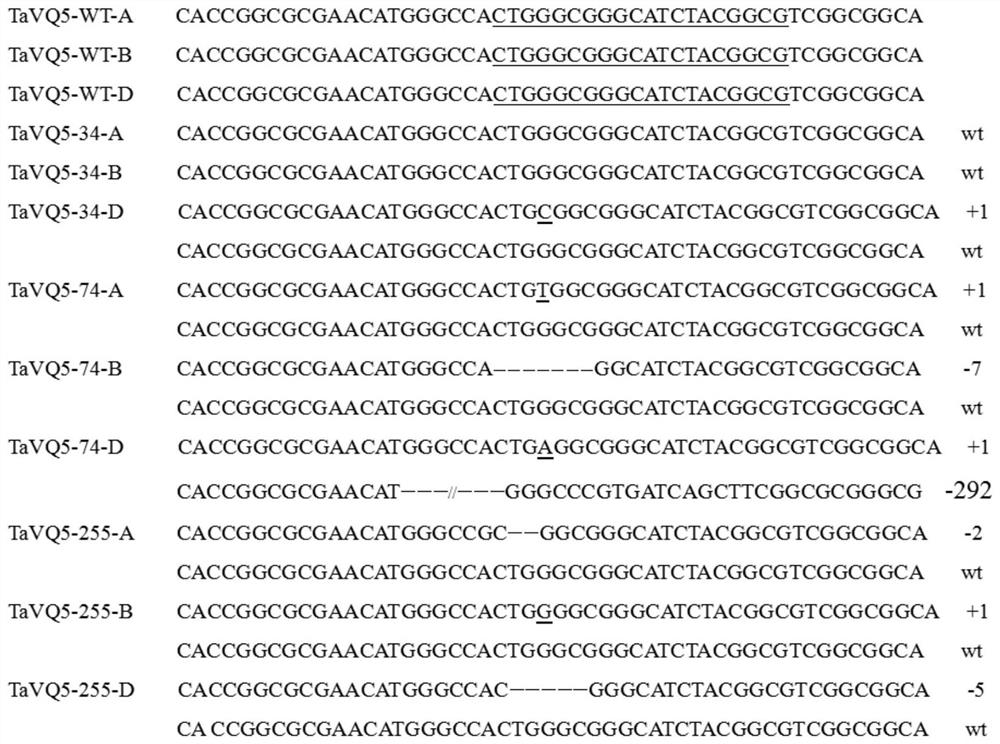Method for improving wheat disease resistance by inhibiting expression of TaVQ5 gene in wheat
A technology of disease resistance and genetics, applied in genetic engineering, plant genetic improvement, chemical instruments and methods, etc., can solve the problems of identification of wheat VQ members and biological functions that need to be further studied
- Summary
- Abstract
- Description
- Claims
- Application Information
AI Technical Summary
Problems solved by technology
Method used
Image
Examples
Embodiment 1
[0058] Embodiment 1, preparation recombinant plasmid
[0059] Artificially synthesized recombinant plasmid pCXUN-Cas9-gRNA. The recombinant plasmid pCXUN-Cas9-gRNA is a circular plasmid. The nucleotide sequence of the recombinant plasmid pCXUN-Cas9-gRNA is shown in Sequence 1 of the sequence listing. From the 5' end in sequence 1, the 115th-367th nucleotides are reverse complementary to the NOS terminator, the 392-4522th nucleotides are reverse-complementary to the coding gene of the Cas9 protein, and the 4544-6533rd nucleotides The acid is reverse complementary to the Ubi promoter, the 6552-6914th nucleotide is the U6 promoter, and the 6915-7017th nucleotide is the coding gene of the sgRNA (the 6915-6934th nucleotide is the target sequence recognition region ). The recombinant plasmid pCXUN-Cas9-gRNA expresses sgRNA, and the target sequence of the sgRNA is located in the wheat TaVQ5 gene, and the specific target sequence is shown in sequence 8 of the sequence listing.
[...
Embodiment 2
[0061] Example 2. Using sgRNA to obtain gene-edited wheat by gene gun method
[0062] 1. Genetic transformation of wheat mediated by gene gun
[0063] 1. The young embryos of wheat variety Zhengmai 7698 about 14 days after pollination were taken as explants. The explants were inoculated in hypertonic medium, and cultured in the dark at 22-25°C for 1-2 days.
[0064] Hyperosmotic medium: MS basic medium with sucrose added, the sucrose concentration is 180g / L.
[0065] 2. Use the recombinant plasmid pCXUN-Cas9-gRNA as the DNA to be transformed, and use the PDS-1000 / He gene gun of BIO-RAD Company to bombard the immature embryos that have completed step 1 (Psi900, 27.5cmHg column), and the immature embryos after bombardment Transfer to induction medium and culture in dark at 22-25°C for 2-3 weeks.
[0066] The induction medium is based on MS medium, supplemented with Vc (vitamin C), 2,4-D (2,4-dichlorophenoxyacetic acid) and sucrose, and the concentration of Vc in the induction...
Embodiment 3
[0114] Embodiment 3, the detection of character
[0115] 1. Material acquisition
[0116] Edited plants for testing: TaVQ5-34, TaVQ5-74, TaVQ5-255 obtained in Example 2 were self-crossed to obtain T 1 Generation plants, the T that will be selected 1 Generation plants were selfed to obtain T 2 Generation seed, according to the method for embodiment 2 to each T 2 Generation plants were identified from T 2 In the generation plants, the homozygous mutation type based on the target sequence was selected, and the plants that did not carry the vector sequence (TaVQ5-34-2-9, TaVQ5-74-2-11, TaVQ5-74-2-19, TaVQ5-74-6 T 3 Generation seed is T 3 Generation of plants that do not carry the vector sequence. will originate from T 0 T of generation plant TaVQ5-34 3 Plants that do not carry the vector sequence in the generation are named T 3 Generation TaVQ5-34, will originate from T 0 T of generation plant TaVQ5-74 3 Plants that do not carry the vector sequence in the generation ar...
PUM
 Login to View More
Login to View More Abstract
Description
Claims
Application Information
 Login to View More
Login to View More - R&D
- Intellectual Property
- Life Sciences
- Materials
- Tech Scout
- Unparalleled Data Quality
- Higher Quality Content
- 60% Fewer Hallucinations
Browse by: Latest US Patents, China's latest patents, Technical Efficacy Thesaurus, Application Domain, Technology Topic, Popular Technical Reports.
© 2025 PatSnap. All rights reserved.Legal|Privacy policy|Modern Slavery Act Transparency Statement|Sitemap|About US| Contact US: help@patsnap.com



